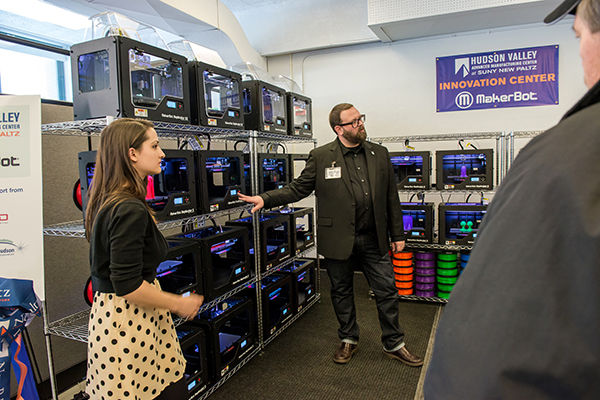

It was a packed house in the McKenna Theatre Lobby this past Tuesday, where more than 100 cameras, media, business leaders, politicians, administrators, professors and students joined in celebrating the grand opening of the nation’s first-ever MakerBot Innovation Center.
SUNY New Paltz celebrated the grand opening of the center on Feb. 11 with a ribbon cutting ceremony and tours of the new 3-D printers and scanners. MakerBot Chief Executive Officer Bre Pettis followed the grand opening with a lecture titled “Leading the Next Industrial Revolution.”
SUNY New Paltz President Donald Christian introduced this new equipment as the first ever of its kind right here on the SUNY New Paltz campus.
“The Hudson Valley Advanced Manufacturing Center integrates the college’s strengths in engineering, computer science, technology and the innovation and creativity of the arts,” Christian said. “It brings state-of-the-art 3-D printing equipment to the region, coupled with the unique curriculum in digital design and fabrication.”
Intended to be a large-scale 3-D printing hub, designed and built in partnership with Brooklyn-based MakerBot, the New Paltz Innovation Center includes 30-plus MakerBot desktop 3-D printers and scanners for student, faculty and local industry use.
CEO of MakerBot, Bre Pettis, called the first-ever center a “step toward democratizing innovation” allowing people greater access to 3-D printing, adding this innovation will set up the stage for exciting things to happen.
“By putting the MakerBot Innovation center here at SUNY New Paltz, we’re giving the students, and frankly the community, an opportunity to be two steps ahead of the world,” Pettis said. “This is really the first time this has been done. I think there’s going to be things that we don’t even know yet what will happen that will emerge because of the seeds we are planting here today.”
Pettis was enthusiastic about allowing students to innovate more freely, noting that athletes never win a race when they first start training.
“The most exciting part is what happens next, when students start doing crazy stuff with this,” he said. “It’s all about empowerment and that’s all about trying and then trying again and celebrating what’s going to happen next.”
Founded in 2009, MakerBot has built the largest installed base of desktop 3-D printers sold to innovative and industry-leading customers worldwide, including engineers, architects, designers, educators and consumers, according to Business Wire.
Pettis compared the new center at New Paltz to having access to computers in the early 80s.
“It gives you a leg up on this technology and gets you ahead of everybody else,” he said. “So when you go apply for a job, you’re the person who has the skills they need. You’re the person who has the experience to be able to get the job done faster. The most important part [of the technology] is the way it changes the way you think. It changes you from being someone who is a consumer, to someone who is a maker and who is solving problems.”
The concept for the center originated out of the President’s office and continued by the work of the local business community, with the initiative launching in May 2013, Provost and Vice President for Academic Affairs Dr. Philip Mauceri said.
“It puts us on the cutting edge of economic development in the region,” Mauceri said. “I think it has enormous potential, no question. As it takes off, it will no doubt be creating jobs and bringing in industries into this region.”
The certificate program at the college began last fall, following an announcement by New York Gov. Andrew Cuomo in December that a $1 million investment of economic development funds that would be given to help grow the sector, helping the local economy, according to Sean Eldridge, president of Hudson River Ventures.
“Thanks to the MakerBot Innovation Center, we are poised to lead the charge in the next wave of advanced manufacturing and to bring good jobs and new manufacturing opportunities right here in the Hudson Valley,” Eldridge said.
The 3-D printers, which cost about $2,200 each, were unveiled to the crowd. Small tours were able to look at the machines at work, creating student projects ranging from a plastic turtle to a colorful chained-link.
Assistant professor in the Art Department Arthur Hash said this technology will create its own link between the arts and engineering departments on campus.
“They really feed off of each other. Often we build walls in between the departments internally, and now it’s really great to have these walls broken down to work together to make New Paltz great,” Hash said. “[Students] bring their skills from the arts and skills from engineering and address and solve problems creatively together.”
Looking toward the future of the center, Hash said the two departments will grow and blossom from their partnership, with students in both departments taking mixed classes together, as well as greater involvement in community projects.
“We need more staff, we need more students, we need more technicians,” he said. “We have all the hardware and I hope this will be the carrot at the end of the stick to attract all kinds of visiting scholars. It’s only a matter of time.”
